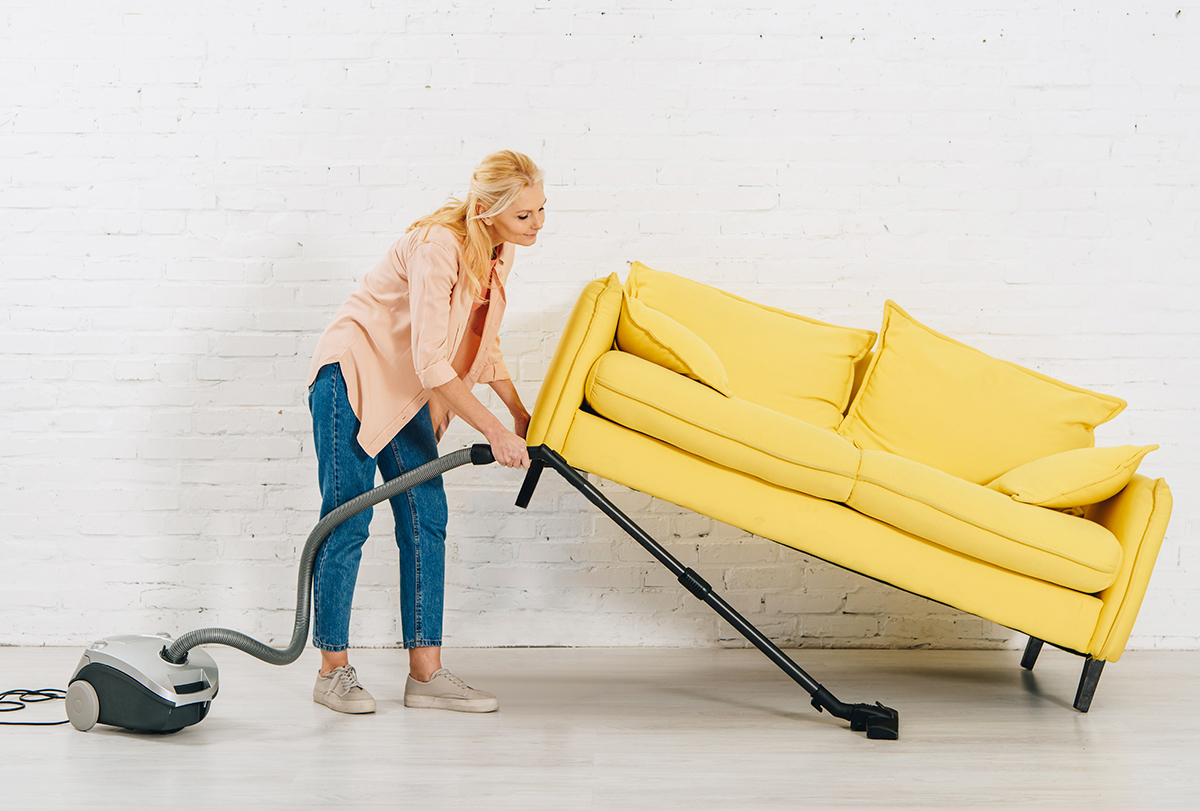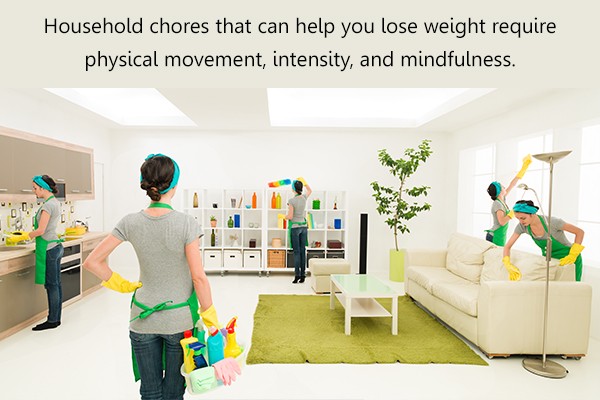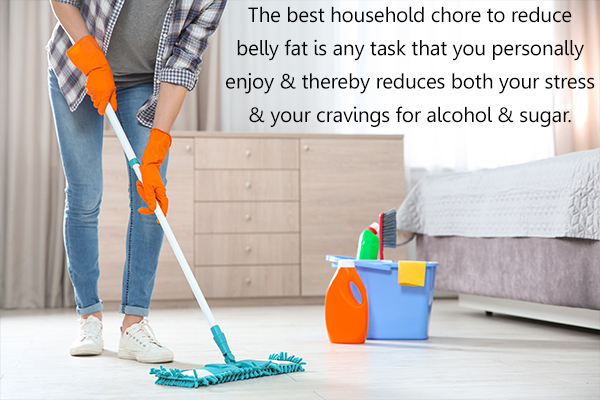In this article:
Household chores are a great way to work out your body while getting your home in order.

Nobody looks forward to mopping the floor or doing the laundry, but a little change in perspective can make these mundane tasks more appealing. Think of these activities as a form of exercise that can help you burn calories and get back in shape without having to leave your home.
Health Benefits of Staying Active Around the House

Doing household chores is a form of physical exercise that can improve your health in the following ways:
1. Promotes weight loss
Exercise plays a key role in losing weight and greater physical activity leads to less weight gain over time. (1)
2. Prevents metabolic syndrome
There is strong evidence that people who stay active or exercise regularly experience other health benefits, such as lowering blood pressure, decreasing blood sugar levels, and reducing the waistline. (2)
High blood pressure, poor blood sugar control, and an expanded waistline, on the other hand, make you more susceptible to metabolic syndrome, which raises your risk for heart disease, diabetes, and stroke.
3. Improves appetite control
Exercise-induced weight loss is associated with physiological and biopsychological changes in the appetite control system or hunger signals. Exercise appears to balance this increased hunger signal (orexigenic drive) by improving the feeling of fullness (satiety response) during a meal.
Sedentary individuals suffer from a malfunctioning or insensitive appetite control system that may be repaired by exercise. (3)
Inactivity may lead to overeating, due to an overabundance of hunger hormones (ghrelin), and understimulated hormones that tell you when you’re full (leptin).
Health Problems Related to a Sedentary Lifestyle
A sedentary lifestyle of inactivity and unhealthy eating habits are associated with weight gain, overweight, and obesity, which are the major underlying causes of modern diseases, such as cardiovascular diseases, cancer, chronic respiratory diseases, diabetes, and dementia.
Research studies are suggestive that physical activity is associated with better health and that physical activity could prevent the development of these diseases. (4)
Can Household Chores Be Considered as Exercises?
Household chores around your home or in your yard are physical activities that require energy and burn calories, which health and fitness professionals refer to as non-exercise activity thermogenesis (NEAT).
Physical activity is defined as unstructured activities incorporated in daily life, whereas exercise is structured and planned activities, both of which have many health benefits.
Increasing daily lifestyle activities is as effective as a structured aerobic exercise program in maintaining long-term weight loss. (5)
Best Household Chores for Losing Weight

Household chores that can help you lose weight require physical movement, intensity, and mindfulness.
The exact number of calories you burn depends on the type of household chore and the length of time you spend completing that activity, as well as your gender, age, height, and weight.
The intensity with which you complete household chores is an important factor. Intensity is determined by movement speed (faster versus slower) and size (bigger versus smaller).
You may double your calorie burn if you boost intensity with faster or bigger movements! It’s also important to note the importance of mindfulness and intention when engaging in any physical activity, including household chores.
Being mindful and intentional, while scrubbing, cleaning, mopping, vacuuming, painting walls, or folding laundry, provides an opportunity to engage specific muscles and stay in proper ergonomic alignment to not only boost intensity but also decrease your risk of injury.
Some of the ideal activities that cover all these aspects include:
- Cleaning windows
- Gardening
- Cooking
- Dusting
- Ironing
- Mopping
- Mowing
- Scrubbing floors
- Yardwork
- Chopping wood
- Cleaning gutters
- Home improvement projects such as painting walls
ALSO READ: 12 Fat-Burning Activities That Don’t Seem Like Exercise
Household Chores That Facilitate Calorie Loss
The household chores that burn the most calories involve resistance training, such as lifting heavy objects, like rearranging furniture.
An individual who weighs 150 pounds may burn 225 calories rearranging furniture in only 30 minutes, which is equivalent to jogging, rowing, or spinning for 30 minutes. So, if you want to change your scenery and sweat without leaving your home, create a new layout for your interior design and get to work by moving furniture!
Calories Burnt During Cooking

Cooking food, instead of ordering takeout, is worth your time to shrink your waistline. When you prepare your own meals, you choose the ingredients and burn calories by chopping, sautéing, and perhaps even dancing in the kitchen!
An individual who weighs 150 pounds may burn 180 calories in an hour cooking up a storm, which is more than you’ll burn waiting for takeout delivery. Moreover, home cooking allows you to regulate how many calories you want in a meal and ensure that only the best ingredients are used.
Can Playing With Children Lead to Calorie Loss?
Playing with children or pets is a heart-pumping and calorie-burning activity that’s also fun! Playing yard games, swimming, bicycling, hula-hooping, or jumping on a trampoline will boost your weight loss and your mood!
Car Washing Is a Good Workout
Next time your car is in need of a clean, opt out of the drive-thru car wash and choose to scrub-a-dub-dub your ride, because an individual who weighs 150 pounds may burn 300 calories during an hour of car washing!
Burn Calories While Shovelling Snow in the Yard
Before you hire someone to plow your driveway when it snows, consider shoveling the snow yourself, because an individual who weighs 150 pounds may burn 400 calories an hour while doing so.
Get Rid of Your Paunch Through Household Work

Belly fat accumulates for a variety of reasons:
- Too much stress
- Too much alcohol
- Too much sugar
- Consuming too many calories over time
The best household chore to reduce belly fat is any task that you personally enjoy and thereby reduces both your stress and your cravings for alcohol and sugar.
Find an activity that gives you joy and mental calm while simultaneously making your world more productive and peaceful.
ALSO READ:
Customizing Your Daily Chores for Quicker Weight Loss
Here is an important tip to remember when trying to lose weight by doing household chores: pump up the burn by maximizing movements and adding functional fitness training moves (squats, lunges, rotations, push and pull) to your typical chores for a “housework workout.” These include:
- Vacuuming lunges
- Dishwashing plie squats
- Dusting calf raises
- Bicep curling grocery bags
- Cutting wood core rotations
- Gardening glute activation
Final Word
Anything that keeps you physically active is a form of exercise, whether it be a specific workout routine, a sport, or general household chores.
So, instead of hiring someone to look after your home, you can try a more hands-on approach and put in the effort yourself. The physical exertion while performing daily household tasks will help you burn calories and strengthen your muscles.
In closing, think twice before hiring a cleaning service or yard service to take those household chores off your hands and paying someone else to do your “housework workout.”
- Was this article helpful?
- YES, THANKS!NOT REALLY


